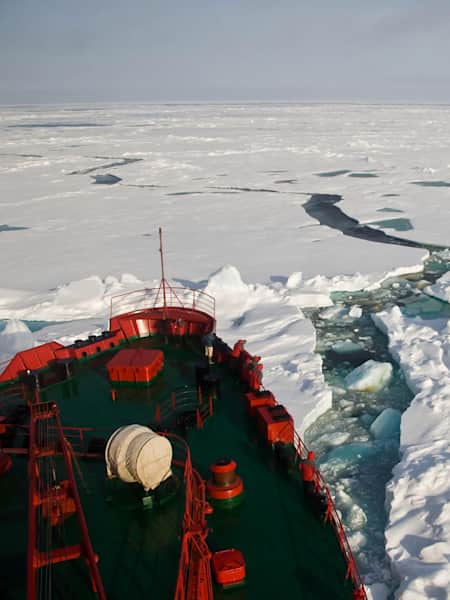The Arctic Ocean is one of the most treacherous stretches of water on Earth. Frozen over for much of the year, it requires a special type of craft to make it through, round or over the ice.
From traditionally built skiffs to giant nuclear-powered ice breakers, there are some incredible boats plying this route regularly, and in some amazing one-off adventures.
Here are a few you might find there.
Ice Rower
Origin: France
Class: Rowing boat
Arctic adventurer Charles Hedrich rowed this boat through the North West passage for three years to support the Respectons La Terre association.
The super-light seven metre carbon and Kevlar boat weighs just 190kg and was specially designed for the nearly 6,000km journey. It has a windmill and solar panels and can move in sea, on ice and ice floes, or be dragged as a sled.
NS Yamal
Origin: Arctic Russia
Class: Nuclear Icebreaker
This big-toothed Russian monster is one of the most powerful icebreakers in the world and can smash through ice up to nine metres thick.
It runs on two nuclear reactors, each of which use 245 enriched uranium fuel rods and enable it to run for five years without a refuel. It is used by state icebreaking firm Atomflot to keep Russia's Arctic waters clear.
SeaXplorer
Origin: Netherlands
Class: Luxury superyacht
Once built this will be the ultimate luxury superyacht, with two submarines, two helicopters and 12 expedition support boats onboard.
Certified as Polar Class – meaning it can travel to the poles – it can carry up to 30 passengers and 50 crew. It travesl at speeds up to 28kph and has a range of 40 days before needing a refuel.
Skin Boats
Origin: Chukotka, Russia
Class: Small traditional row or sail boat
These traditional arctic boats, known as Chukchi-Eskimo baidara, are made with a driftwood frame covered in female walrus hide.
They are used by the Chukchi and Yupik Eskimo to hunt Bowhead whales and are also raced in the Beringia Games, which sees teams from arctic nations compete on the Bering Strait. It next takes place in July 2016.
Vulkana
Origin: Tromso, Norway
Class: Wooden hulled converted trawler
Travelling through the waters of the Norwegian Arctic around the Lyngen Alps, this is the ultimate mobile spa.
Above deck is a bubbling hot tub and below, with picture windows, a sauna, spa and a series of rooms for massage sessions. Sailing in winter has never been so luxurious.
Avanaa-Kitaa
Origin: France
Class: Pedal boat
Designed to take adventurer Charles Manini through the ice maze of channels in the North West passage, this will be the world's most advanced pedalo.
Still in the pre-build phase awaiting additional sponsorship, the boat has twin 40cm propellers capable of holding a three-to-four knots cruising speed. The journey is due to take place in summer 2017.
Babouchka
Origin: France
Class: Catamaran/ Ice Boat
Sebastien Roubinet and Vincent Berthet used this hybrid catamaran ice boat in an attempt to cross the Arctic Ocean and reach the North Pole in 2013.
Capable of sailing on both water and ice, its onboard instruments, powered by Solbian flexible solar panels, planned to measure polar ice thickness but low winds ended the mission and the pair were rescued by an icebreaker.
Seawolf Kayak
Origin: USA
Class: Single-person kayak
The manufacturers of these beautiful modern traditional skin-on-frame kayaks say they are designed to handle 'violent' waters, like those found in the arctic.
Despite using traditional all-natural materials, they are tough, can cruise up to speeds of 3.25 knots and roll 'like a weighed punchbag', so stay upright in even the roughest seas.
Seawolf Submarine
Origin: USA
Class: Nuclear submarine
The US Navy's Seawolf submarines can spend up to two months negotiating undersea ice formations before surfacing near the North Pole.
The nuclear-powered vessels are just over 100m long and can travel at up to 65kph. During regular sub-Arctic explorations, they travel with a near limitless range, restricted only by the food supplies they can carry onboard.











